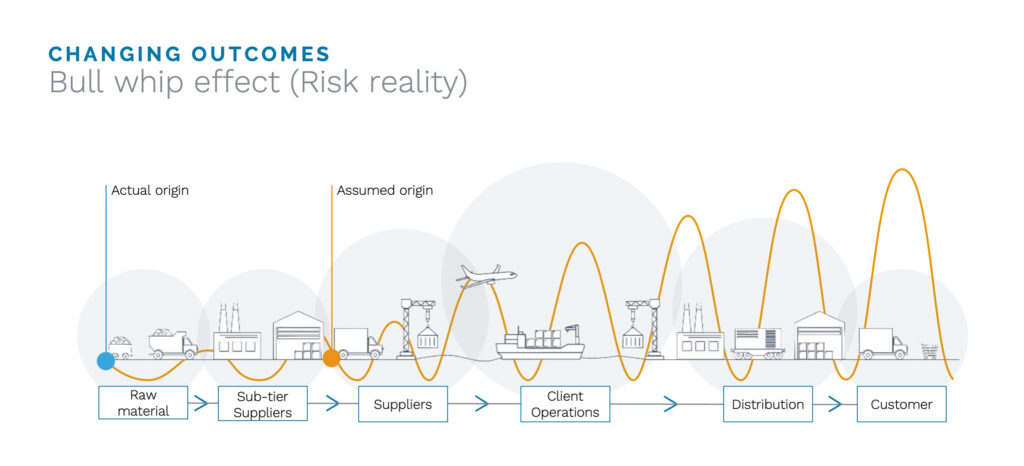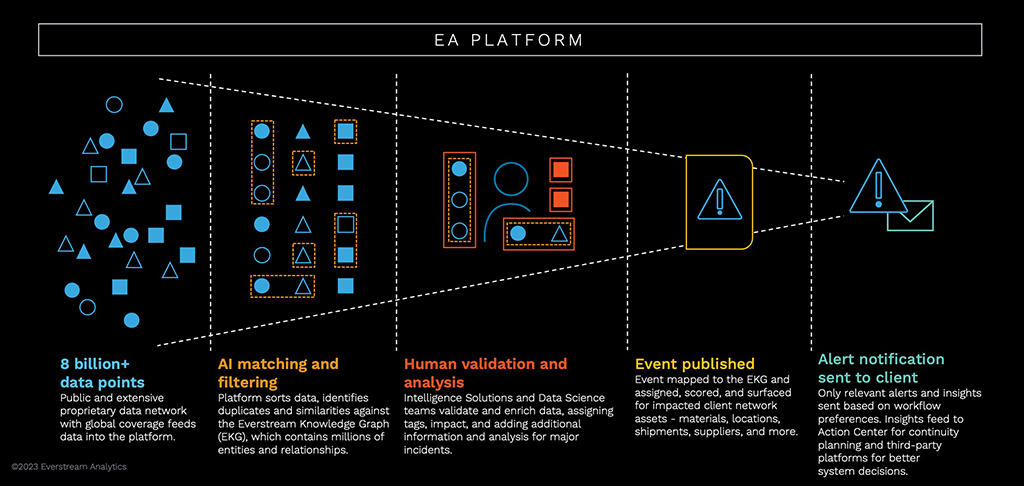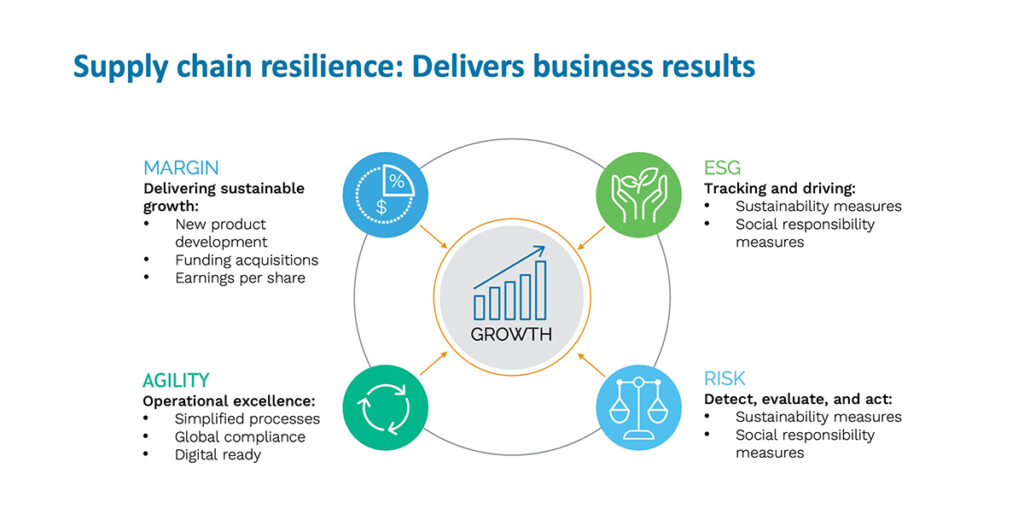Supply chain planning is all about managing risks to operations. Unfortunately, many organizations are still playing defense – dealing with disruptions to the supply chain as they happen instead of using tools for anticipating and mitigating risks before they occur. Some blame the fact that they lack the tools to predict risks ahead of time, while others are so used to standard operating procedures, they don’t know there is a better way.
Understanding the difference between reactive and proactive business strategies couldn’t be more critical to the supply chain. In the simplest terms, the two approaches can be defined this way: Reactive business strategies are those that respond to some unanticipated event only after it occurs, while proactive strategies are designed to anticipate possible challenges. When so much is riding on optimizing the supply chain, it’s obvious that a proactive strategy towards risk management is the approach savvy organizations must take.
Proactive planning for more responsive risk mitigation
The unknown is always scarier than the known. When you know what you’re dealing with, you can plan and take action. But when an event is “unanticipated,” it can wreak havoc, sending supply chain leaders into a frenzy as they try to stop the bleeding as quickly as possible while also keeping operations running. Not every enterprise risk can be predicted, but proactive organizations are good at assessing potential risks and developing plans to manage them if and when they occur.

Figure 1: The later a risk is discovered and managed, the more disruption is causes.
To “plan” is to devise a future course of action. In order to plan for the future, you need facts, many of which may not be completely known yet. In these cases, you need the best data possible that gives decision makers enough information to make decisions with confidence. This hasn’t always been easy because data is often inaccessible, dispersed among multiple systems, or uncollected and, therefore, unused. Manually collecting and analyzing dynamic data is nearly impossible. Artificial intelligence is now filling this void by gathering the most relevant data from multiple sources and automatically analyzing it to provide predictions.
The alternative is to continue being in a reactive state, defined as “reacting to events or situations rather than doing something first in order to change or prevent something.” It’s not a fun or effective way to operate and can eventually put the organization and the entire supply chain at risk with economic consequences.
If your organization is committed to becoming more agile and proactive in assessing, predicting, and mitigating supply chain risk, here are four tips to follow:
Tip #1: Automate your processes
How are you currently identifying risk? Is it a manual effort with static spreadsheets that contain data that is outdated as soon as it is entered? Are you unsure that you are seeing all the data that could influence your assessment, even as that data changes minute by minute or second by second? Are you struggling to deduce real, concrete next steps from your risk evaluation?
If any of this sounds familiar, there’s a good chance you’re still missing critical pieces to the puzzle. If you don’t have the right data, you can’t be proactive in mitigating risk, particularly when risks have been uncommon in the past. Intelligent analytics really shine here, identifying even remote risks and giving those risks a probability score so they are at least on the radar.

Figure 2: The most effective tools for anticipating and mitigating risk employ technology with human oversight.
Automation speeds the identification of risk, thereby speeding the process of mitigating those risks. This gives supply chain leaders valuable extra time to proactively plan so that upstream and downstream problems have less of an effect on the bottom line.
By shifting towards a more automated, proactive risk assessment and analysis, companies can rapidly respond to emergent risks and have time to plan for more eventual risks. The key, however, is to have an integrated solution that continually collects real-time supply chain data and can be configured to provide notifications of risks across all nodes in the supply chain. The best part of this solution is that it consumes little resource time or expertise yet provides reliable, actionable data that informs decisions.
Tip #2: Measure the right things
Do you know the status of your supply chain right now? How long would it take to get a full picture? For many organizations that rely on traditional planning, there is little to no visibility into the entire supply chain and all its risks. CEOs are often concerned about the quality of the data they’re basing their decisions on. The data they do have is often unreliable, incomplete, and too late, yet they base all their decisions on that data. They have little chance of being proactive and instead must do the best they can to manage a threat after it has already become an event.
All data isn’t created equal, however. Irrelevant or unreliable data only clouds decisions and can send leaders on the wrong track. Measuring the right data points is the best way to ensure an effective supply chain risk mitigation strategy.
Here’s the kicker: the data must also be predictive. Once a shipment is already en route, there’s little you can do to mitigate any risks. At this point, you’re just reactive and hoping for the best. Having software that can provide intelligent analytics using key performance metrics early gives companies the opportunity to predict what is likely to happen and change plans. Whether it’s choosing a different sub tier supplier, shipping mode, or another variable, it’s important to be able to model each what-if scenario to see which action is optimal.
Overlooking risks because of bad or incomplete data allows those risks to fester, building momentum that endangers the supply chain. Only with real-time data can business leaders be confident in their decisions on how best to control the impact any risk can have on the supply chain. An integrated solution that takes advantage of modern technology will collect, analyze, and present data continually in an actionable way so leaders proactively plan instead of reactively responding.
One of the greatest capabilities of intelligent analytics is to score risks to prioritize them based on their severity and probability so companies are focused on the right risks at the right time. The analytics can score for logistics factors including multi-modes, including global, multimodal, distribution centers and ports; and for procurement risk including extreme weather, political unrest, emerging regulations, and more. Risk scoring brings the data to life, making easy to visualize risk instead of only conceptualizing. A dashboard presents the reports, scoring, and data leaders most want to see, including the best options for mitigating risks.
Tip #3: Adapt to change
You can’t avoid or prevent change. The best way to handle change is to be able to anticipate it, plan for it, and learn from it. If your organization has been operating in a reactive mode, taking a more proactive planning strategy can be challenging but worth the effort. The supply chain is constantly evolving and so should the technology that supports it. Manual risk assessments and mitigation efforts simply can’t keep up over the long haul. In fact, organizations lagging behind will likely be left in the dust as partners, suppliers, and customers increasingly prefer to work with companies that are better able to mitigate risks to minimize disruptions to the supply chain.
A more responsive, agile supply chain incorporates integrated data from various sources. They automate processes, including reporting, analytics, and prioritization. All stakeholders have full visibility into the supply chain and all the risks in and outside of the enterprise. This is change worth the investment.
Modern supply chain risk management includes software that uses machine learning, artificial intelligence, and multi-factor prescriptive analytics to automatically identify risks across the supply chain. Everything from weather events that can damage facilities or delay shipments to infrastructure outages or political upheaval are now more predictable so there are fewer surprises and wasted costs.

Figure 3: Using tools for anticipating and mitigating risk, operations achieve operational and financial gains.
Change, too, may have a cost, but this modern technology brings significant cost savings as well. With more reliable data and proactive strategies to mitigate risks, there are fewer disruptions to the supply chain, less damaged or missing freight, greater customer satisfaction, and a more efficient supply chain. Even simple changes to a shipment’s schedule, mode of transportation, lane, or carrier type can save costs. Reefer trucks, for example, are expensive and potentially unnecessary if temperatures along the route have a high likelihood of remaining within tolerance levels. Once the shipment leaves on a reefer truck, however, the opportunity to change the transportation type is gone. The money is spent. Dynamic planning enables companies to be more agile to changes in the weather, schedules, freight, customer demands, and even world events that can impact the supply chain.
Tip #4: Invest in industry-leading supply chain risk software
As more companies automate their supply chain risk management efforts, there are more options on the market. The majority of supply chain risk software only identifies and monitors risks. This is still a step forward, but more is needed to truly enable proactive risk management. Only software that includes predictive and prescriptive analytics can identify current risks, anticipate potential future risks, and offer leaders insight into which course of action is best to mitigate those risks. Companies must go beyond simply understand risks exist but to prioritize risks and plan to eliminate or mitigate the threat.
This capability is only possible through integration, automation, and intelligent analytics. Not all software offers risk scoring as a core capability, either. Make sure the technology you choose helps you visualize risks in real-time to speed decision making.
The time to shift from reactive supply chain risk management to proactive supply chain risk management is now. Choose the software capable of detecting and analyzing risks along with comprehensive logistics data to provide you with a clearer picture of your supply chain. When you have real-time, reliable data at your fingertips to empower proactive planning, risk management becomes a differentiator.
Read our eBook to learn more about the cost/benefit analysis of risk management software.